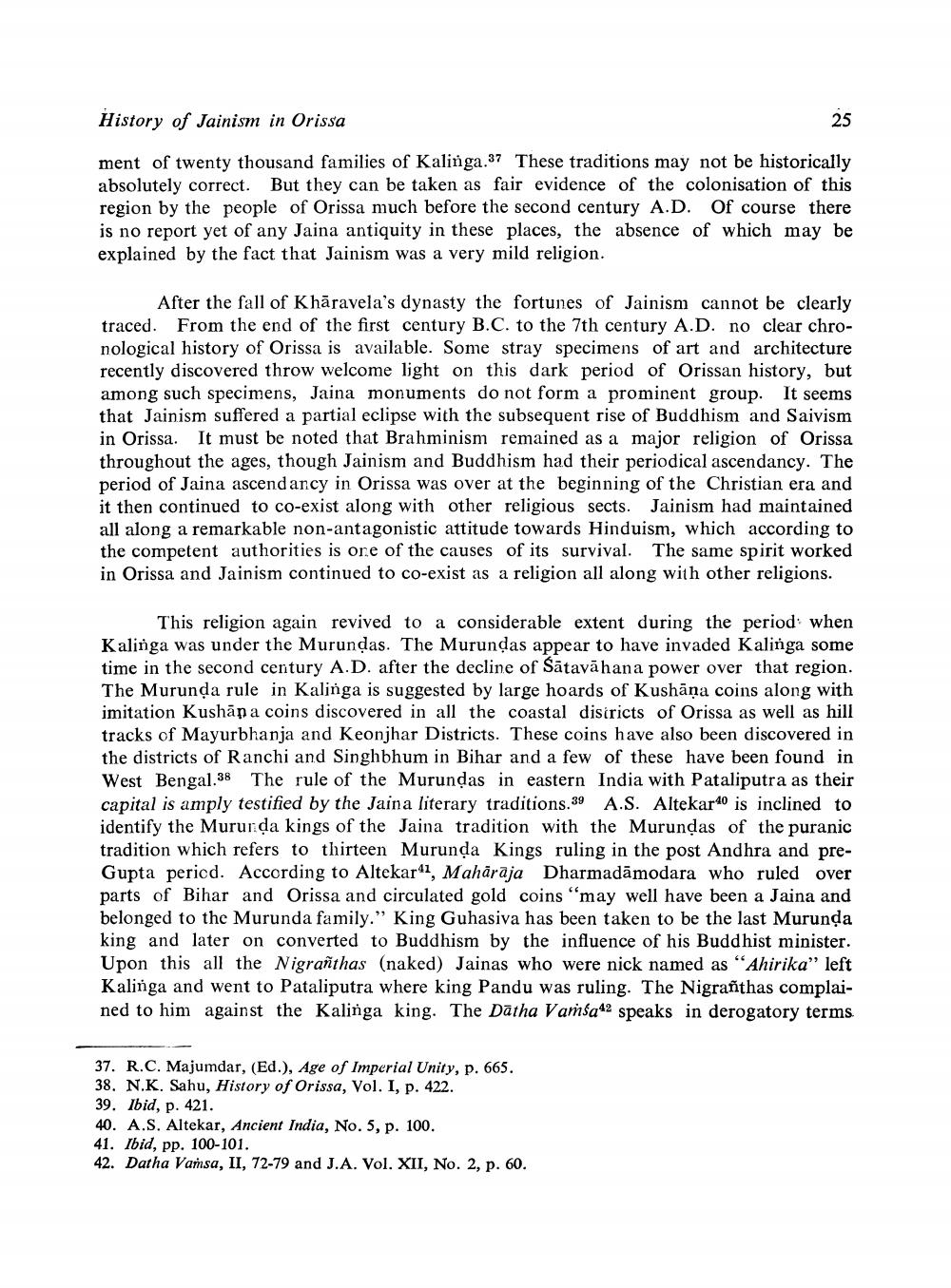________________
History of Jainism in Orissa
25
ment of twenty thousand families of Kalinga.37 These traditions may not be historically absolutely correct. But they can be taken as fair evidence of the colonisation of this region by the people of Orissa much before the second century A.D. Of course there is no report yet of any Jaina antiquity in these places, the absence of which may be explained by the fact that Jainism was a very mild religion.
After the fall of Khāravela's dynasty the fortunes of Jainism cannot be clearly traced. From the end of the first century B.C. to the 7th century A.D. no clear chronological history of Orissa is available. Some stray specimens of art and architecture recently discovered throw welcome light on this dark period of Orissan history, but among such specimens, Jaina monuments do not form a prominent group. It seems that Jainism suffered a partial eclipse with the subsequent rise of Buddhism and Saivism in Orissa. It must be noted that Brahminism remained as a major religion of Orissa throughout the ages, though Jainism and Buddhism had their periodical ascendancy. The period of Jaina ascendancy in Orissa was over at the beginning of the Christian era and it then continued to co-exist along with other religious sects. Jainism had maintained all along a remarkable non-antagonistic attitude towards Hinduism, which according to the competent authorities is one of the causes of its survival. The same spirit worked in Orissa and Jainism continued to co-exist as a religion all along with other religions.
This religion again revived to a considerable extent during the period: when Kalinga was under the Murundas. The Murundas appear to have invaded Kalinga some time in the second century A.D. after the decline of Sātavāhana power over that region. The Murunda rule in Kalinga is suggested by large hoards of Kushāņa coins along with imitation Kushāna coins discovered in all the coastal disiricts of Orissa as well as hill tracks of Mayurbhanja and Keonjhar Districts. These coins have also been discovered in the districts of Ranchi and Singhbhum in Bihar and a few of these have been found in West Bengal.38 The rule of the Murundas in eastern India with Pataliputra as their capital is amply testified by the Jaina literary traditions.39 A.S. Altekar40 is inclined to identify the Mururda kings of the Jaina tradition with the Murundas of the puranic tradition which refers to thirteen Murunda Kings ruling in the post Andhra and preGupta period. According to Altekar", Mahārāja Dharmadāmodara who ruled over parts of Bihar and Orissa and circulated gold coins "may well have been a Jaina and belonged to the Murunda family." King Guhasiva has been taken to be the last Murunda king and later on converted to Buddhism by the influence of his Buddhist minister. Upon this all the Nigrañthas (naked) Jainas who were nick named as "Ahirika" left Kalinga and went to Pataliputra where king Pandu was ruling. The Nigrañthas complained to him against the Kalinga king. The Dātha Vaṁsa42 speaks in derogatory terms
37. R.C. Majumdar, (Ed.), Age of Imperial Unity, p. 665. 38. N.K. Sahu, History of Orissa, Vol. I, p. 422. 39. Ibid, p. 421. 40. A.S. Altekar, Ancient India, No. 5, p. 100. 41. Ibid, pp. 100-101. 42. Datha Vamsa, II, 72-79 and J.A. Vol. XII, No. 2, p. 60.




